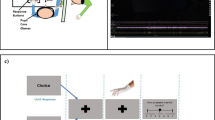Abstract
Eastern and Western interpretations of contextual control of phasic conditional responses (transswitching) are contrasted. The Eastern (Asratyan, 1965) approach emphasizes the role of the tonic conditional stimulus and the (hypothetical) tonic response it evokes. The Western (Lachnit, 1986) approach emphasizes the role of compound conditional stimuli. Although Lachnit showed that transswitching-like results can be obtained without a tonic stimulus, attempts to simulate transswitching experiments using a computer model of the Rescorla-Wagner theory (Kimmel and Lachnit, 1988) have shown that predictions from the theory approximate empirical results in human classical conditioning only when the tonic stimulus is given far greater weight than the phasic stimulus. In other words, only when the Rescorla-Wagner theory is made more like Asratyan’s theory, can the compound conditional stimulus approach account for real empirical transswitching data.
Similar content being viewed by others
References
Asratyan, E. A. (1965)Compensatory adaption, reflex activity, and the brain (S. A. Corson, Trans.). New York: Oxford University Press.
Kimmel, H. D., & Ray, R. L. (1978) Transswitching: Conditioning with tonic and phasic stimuli.Journal of Experimental Psychology: General, 107, 187–205.
Kimmel, H. D., & Lachnit, H. (1988) The Rescorla-Wagner theory does not predict contextual control of phasic responses in transswitching.Biological Psychology, 27, 95–112.
Lachnit, H. (1986) Transswitching and contextual conditioning. Relevant aspects of time.The Pavlovian Journal of Biological Science, 21, 160–172.
Lachnit, H., & Hentschel, S. (1988) Transswitching and contextual conditioning: Elaboration of an alternative explanation.The German Journal of Psychology, 12, 237–238.
Lachnit, H., Schneider, R. L., Lipp, O. V. & Kimmel, H. D. (1988) RWMODEL: A program in Turbo Pascal for simulating predictions based on the Rescorla-Wagner model of classical conditioning.Behavior Research Methods, Instruments, & Computers, 20, 413–415.
Rescorla, R. A., & Wagner, A. R. (1972) A theory of Pavlovian conditioning: Variations in the effectiveness of reinforcement and nonreinforcement. In A. H. Black & W. F. Prokasy (Eds.),Classical conditioning II: Current theory and research. New York: Appleton-Century-Crofts.
Author information
Authors and Affiliations
Corresponding author
Rights and permissions
About this article
Cite this article
Lachnit, H., Kimmel, H.D. Contextual conditioning. Pav. J. Biol. Sci. 25, 174–179 (1990). https://doi.org/10.1007/BF02900700
Issue Date:
DOI: https://doi.org/10.1007/BF02900700




